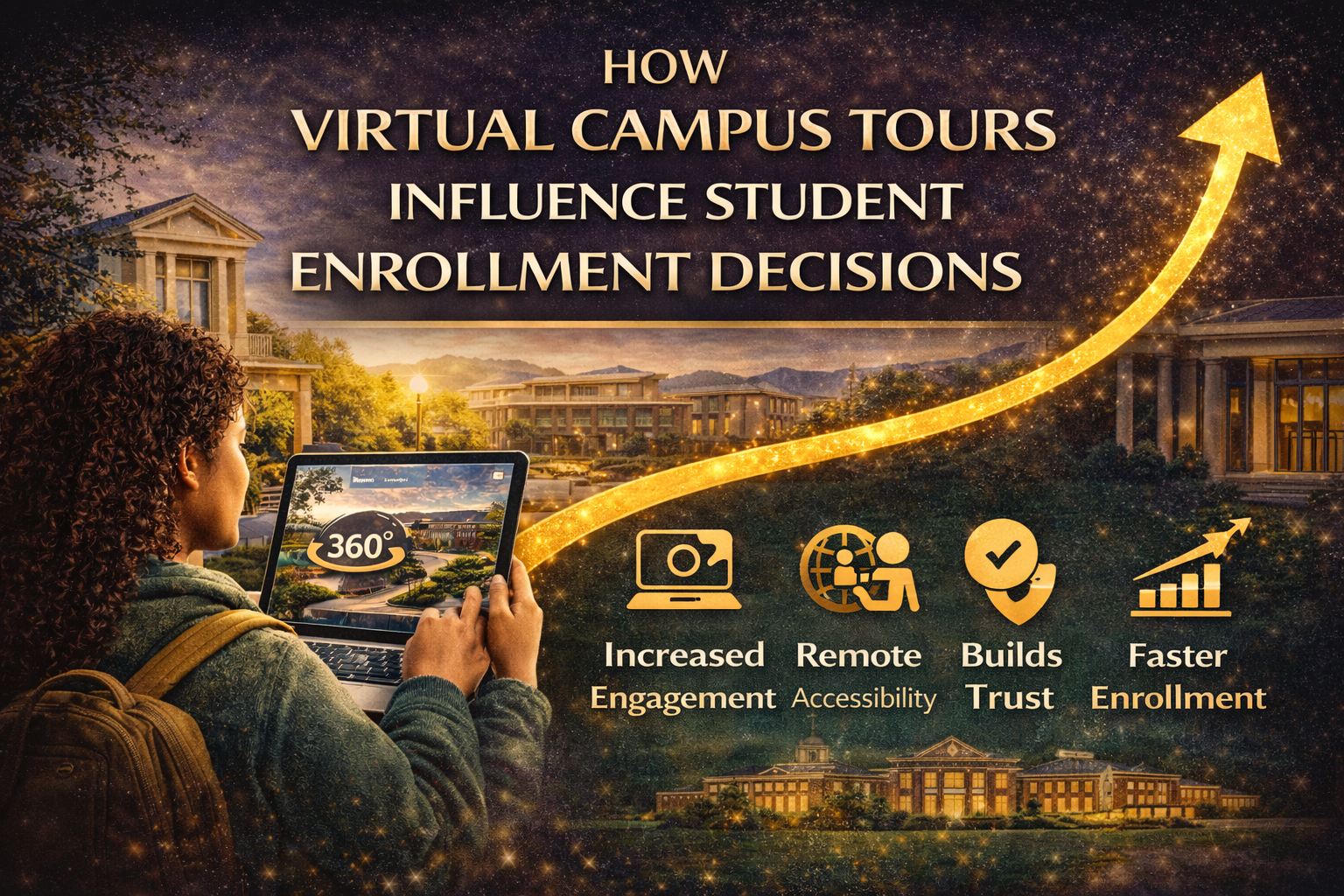In today's world, where travel can feel out of reach for many, virtual tour 360 experiences are changing the game. They allow anyone to explore the globe from the comfort of their own home. With just a few clicks, you can visit iconic landmarks, dive into breathtaking natural wonders, or stroll through vibrant city streets. This article will guide you through the ins and outs of virtual tours, highlighting their benefits, tips for maximizing your experience, and what the future holds for this exciting technology.
Key Takeaways
- Virtual tour 360 experiences make global exploration accessible to everyone, regardless of physical limitations.
- These tours offer unmatched convenience, allowing you to travel without the usual hassles of planning and logistics.
- You can personalize your journey, choosing what to see and when to explore without any time constraints.
- Investing in good equipment, like a VR headset, can enhance your immersive experience significantly.
- The future of virtual tours looks bright with advancements in technology, making them even more realistic and interactive.
Understanding The Concept Of Virtual Tour 360

What Is A Virtual Tour 360?
Okay, so what is a virtual tour 360? Basically, it's a way to check out a place remotely, but it's way cooler than just looking at pictures. It's like you're actually there, able to look around in every direction. Think of it as a digital twin of a real-world location. You can use your computer, phone, or even a VR headset to experience it. It's a pretty neat way to see the world without leaving your couch. You can check out various angles on your device.
How 360-Degree Virtual Tours Work
So, how do these things actually work? It's all about capturing a complete view of a space. Photographers use special cameras, often with multiple lenses, to take a bunch of pictures from every angle. Then, software stitches all those images together to create one big, seamless 360-degree image. When you're "in" the tour, you're basically looking at that stitched-together image, and you can pan around to see everything. Some tours even add sound effects or interactive elements to make it feel even more real. It's pretty clever, really. It gives you the feeling of being physically present in a location.
The Technology Behind Virtual Tours
There's a lot going on behind the scenes to make virtual tours happen. It's not just about the cameras, although they're important. You also need powerful computers and software to process all those images and create the tour. And then there's the tech that lets you view the tour – everything from web browsers to VR headsets. The quality of the virtual tour depends on the equipment. It's a mix of hardware and software working together to create an immersive experience.
Virtual tours are becoming more common because the technology is getting better and cheaper. It's now easier than ever to create and share these experiences, which is why you're seeing them used in everything from real estate to tourism. It's a trend that's likely to continue as technology improves.
Benefits Of Experiencing Virtual Tour 360

Accessibility For All
Virtual tours are great because they let almost anyone see the world. Got mobility issues? No problem. Live far away? Doesn't matter. Virtual tours break down those barriers. It's like having a magic portal to anywhere you want, right from your couch. This opens up travel to people who might never get the chance otherwise. It's a really cool way to make the world more accessible.
Convenience Of Virtual Travel
Forget about booking flights, packing bags, or dealing with airport security. Virtual travel is all about chilling at home and exploring the world at your own pace. You can pause, rewind, and zoom in on whatever catches your eye. It's like having a personal time machine and tour guide all rolled into one. Plus, you save a ton of money on travel expenses. Who wouldn't want to explore properties without leaving their living room?
Personalized Exploration
Virtual tours let you be the boss of your adventure. Want to spend an hour staring at a painting in the Louvre? Go for it. Interested in the history of a specific monument? Dive right in. You get to choose what you see and how long you spend there. It's all about creating your own unique experience. No more being herded around in a big group or stuck on a rigid schedule. It's your trip, your way.
I remember when I first tried a virtual tour. I was blown away by how much control I had. I spent ages just wandering around a museum, looking at things that interested me. It was way more engaging than any guided tour I've ever been on.
Tips For Maximizing Your Virtual Tour 360 Experience
Choosing The Right Equipment
Okay, so you're ready to jump into the world of virtual tours? Awesome! But before you do, let's talk gear. You don't need to break the bank, but having the right stuff can seriously up your experience. Think of it like this: you wouldn't run a marathon in flip-flops, right? Same idea here.
- First, consider your viewing device. A VR headset is the gold standard for immersion, but a decent computer or tablet works too. Just make sure the screen is big enough to really see what's going on.
- Next, headphones are a must. Good audio adds so much to the experience. Noise-canceling ones are great if you're easily distracted.
- Finally, check your internet connection. Nothing kills a virtual tour faster than constant buffering. A stable, high-speed connection is key. You might want to enhance your online virtual reality experience by optimizing your internet connection.
Navigating Virtual Environments
Alright, you've got your gear, now what? Don't just jump in and start clicking randomly. Take a second to get your bearings. Most virtual tours have some kind of navigation system, whether it's arrows, hotspots, or a mini-map. Learn how it works before you start exploring. It'll save you a lot of frustration.
- Look for interactive elements. Many tours have hidden features or extra information you can access by clicking on things.
- Use the zoom function. Get up close and personal with the details. You might be surprised what you find.
- Don't be afraid to experiment. Try different viewing angles and perspectives. See what works best for you.
It's easy to get disoriented in a virtual space, especially if you're using a VR headset. Take breaks if you start to feel dizzy or nauseous. And always be aware of your surroundings in the real world to avoid bumping into things.
Taking Your Time To Explore
This is probably the most important tip of all: don't rush! Virtual tours aren't meant to be speedruns. They're meant to be savored. Take your time, explore every nook and cranny, and really soak it all in. Think of it as a leisurely stroll through a museum, not a race to the finish line. You can always find virtual tours to explore.
- Read the descriptions. Most tours have text or audio guides that provide context and information about what you're seeing.
- Listen to the sounds. Ambient noise can add a lot to the atmosphere and make the experience more immersive.
- Imagine yourself there. Try to picture what it would be like to actually be in that place. What would you smell? What would you feel? The more you engage your senses, the more memorable the experience will be.
Planning Your Virtual Tour 360 Itinerary
Planning a virtual tour can be just as exciting as planning a real-world trip! It's all about figuring out where you want to "go" and how to make the most of your time. Think of it as curating your own personalized adventure from the comfort of your home. It's a great way to see the world without the hassle of travel.
Selecting Destinations
First things first: where do you want to go? The beauty of virtual tours is that the world is your oyster. Are you dreaming of exploring ancient ruins, wandering through art museums, or maybe even checking out a virtual campus tour? Consider your interests and passions to guide your choices. Don't be afraid to think outside the box – maybe there's a niche museum or a hidden gem you've always wanted to see. Make a list of places that spark your curiosity.
Researching Virtual Tour Platforms
Not all virtual tour platforms are created equal. Some offer higher-quality visuals, better interactivity, or a wider selection of destinations. Do some digging to find platforms that align with your needs and preferences. Look for user reviews and ratings to get an idea of the experience. Some platforms specialize in certain types of tours, like historical sites or natural wonders. It's worth checking out a few different options to see what's out there. A good platform can really transport you to another place.
Creating A Balanced Schedule
Just like with real travel, it's easy to get burned out if you try to cram too much into one day. Plan a balanced schedule that allows you to fully appreciate each destination without feeling rushed. Consider the length of each tour and factor in breaks for snacks, stretching, or just relaxing. Maybe alternate between more intense, information-heavy tours and lighter, more visually focused ones. Remember, the goal is to enjoy the experience, not to check off a list of places. Think of it as pacing yourself for a marathon of exploration. You can find many virtual tours online.
It's easy to get carried away with the possibilities, but remember to be realistic about how much you can comfortably experience in a single session. Overloading your schedule can lead to fatigue and diminish your enjoyment. Instead, focus on quality over quantity, and allow yourself ample time to savor each virtual destination.
The Future Of Virtual Tour 360 Technology
Advancements In Virtual Reality
The world of virtual reality is changing fast, and it's not just about gaming anymore. Virtual tour 360 experiences are set to get a major upgrade thanks to these advancements. Think better resolution, more realistic environments, and headsets that are actually comfortable to wear for extended periods. It's all about making the experience more immersive and accessible. The goal is to make you feel like you're really there, whether you're exploring ancient ruins or walking through a museum.
Integration Of Artificial Intelligence
Imagine having a virtual tour guide that knows exactly what you're interested in. That's the promise of AI integration. AI could personalize tours in real-time, answering questions, providing translations, and even adapting the tour based on your preferences. It's like having a personal expert with you every step of the way. This could really change digital personas and make learning about new places way more engaging.
The Impact Of 5G On Virtual Tours
5G isn't just about faster downloads on your phone; it's going to revolutionize virtual tours. With faster internet speeds and lower latency, virtual tours will become more seamless and responsive. No more lag or buffering – just smooth, high-quality experiences. This means you can explore remote locations without any interruptions, making virtual travel feel even more real. It's a game-changer for accessibility and convenience.
The emotional impact of experiencing a virtual tour is much stronger than viewing regular photos. People engage more with this type of content. Brands using VR are seen as more modern. This shows the potential of virtual tours to connect with audiences on a deeper level.
Here are some potential future developments:
- Holographic tour guides
- Interactive elements within the tours
- Multi-sensory experiences (smell, touch)
Exploring Different Types Of Virtual Tour 360
Cultural And Historical Tours
These tours let you visit museums, historical sites, and cultural landmarks from anywhere. Imagine exploring the Louvre in Paris or walking through the ancient ruins of Rome without leaving your couch. It's a great way to learn and experience different cultures. You can often find expert narrators who provide insights and stories as you explore, adding an educational layer to the experience.
Nature And Adventure Tours
If you love the outdoors, these tours are for you. You can explore national parks, hike through rainforests, or even dive into the Great Barrier Reef. It's a fantastic way to see the world's natural wonders, especially if you can't travel physically. These tours often feature stunning visuals and ambient sounds to make the experience more immersive.
Here are some popular nature and adventure virtual tours:
- National Parks in the USA
- Amazon Rainforest
- Mount Everest Base Camp
Virtual tours provide an inclusive and accessible way for everyone to satisfy their wanderlust. With just a few clicks, you can transport yourself to the top of the Eiffel Tower, dive into the Great Barrier Reef, or wander through the ancient ruins of Machu Picchu.
Real Estate Virtual Tours
These tours are designed to let you view properties remotely. Whether you're buying, selling, or renting, you can get a good sense of a place without having to visit in person. It's a convenient way to narrow down your options and save time. Real estate virtual tours are becoming increasingly popular, offering a convenient way to explore properties from the comfort of your home.
They typically include:
- 360-degree views of each room
- Floor plans
- Interactive elements to highlight key features
Engaging With Virtual Tour 360 Communities
Joining Online Forums
Online forums are a great way to connect with other virtual tour enthusiasts. You can find forums dedicated to specific types of tours, like historical sites or natural wonders. These platforms let you ask questions, share your experiences, and learn from others. It's like having a travel buddy, but online! You can find tips on participating in virtual council meetings and other online events.
Participating In Virtual Events
Virtual events, such as live tours or Q&A sessions with experts, offer a more interactive experience. These events allow you to engage in real-time with guides and other participants, making the virtual tour feel more alive. It's a chance to ask questions, get immediate feedback, and feel like you're part of a group exploring together.
Sharing Your Experiences
Don't keep your virtual adventures to yourself! Share your experiences on social media, blogs, or virtual tour platforms.
Here are some ways to share:
- Write a blog post about your favorite tour.
- Post photos or videos on social media.
- Leave reviews on virtual tour platforms.
Sharing your experiences not only helps others discover new tours but also allows you to reflect on what you've learned and seen. It's a way to contribute to the community and inspire others to explore the world virtually.
Wrap Up Your Virtual Adventure
So, there you have it! Virtual tours are a game changer for anyone wanting to explore the world without the hassle of travel. Whether you're stuck at home or just looking to save some cash, these tours let you see amazing places with just a few clicks. You can check out famous landmarks, dive into beautiful oceans, or stroll through ancient cities—all from your couch. Plus, with tech getting better every day, the experience is only going to improve. So why not give it a shot? Embrace this new way of exploring and let your curiosity lead the way!
Frequently Asked Questions
What is a 360-degree virtual tour?
A 360-degree virtual tour is an online experience that lets you explore places as if you were actually there. You can look around in every direction and see everything in detail.
How do 360-degree virtual tours work?
These tours use special cameras to take pictures from all angles. The photos are then combined to create a single image that you can move around in, making it feel like you're really there.
What equipment do I need for a virtual tour?
You can enjoy virtual tours on a computer, tablet, or smartphone. For a better experience, a virtual reality headset can make it feel even more real.
What are the benefits of virtual tours?
Virtual tours are great because they allow anyone to explore places they might not be able to visit in person, like due to distance or cost. They also let you travel at your own pace.
Can I interact with virtual tours?
Yes! Many virtual tours have interactive features like clickable points for more information, sounds, and even guided tours with audio explanations.
What is the future of virtual tours?
The future looks bright! With new technology, virtual tours will become even more realistic and engaging, thanks to faster internet and better virtual reality tools.














.png)



.png)







.png)

.png)





